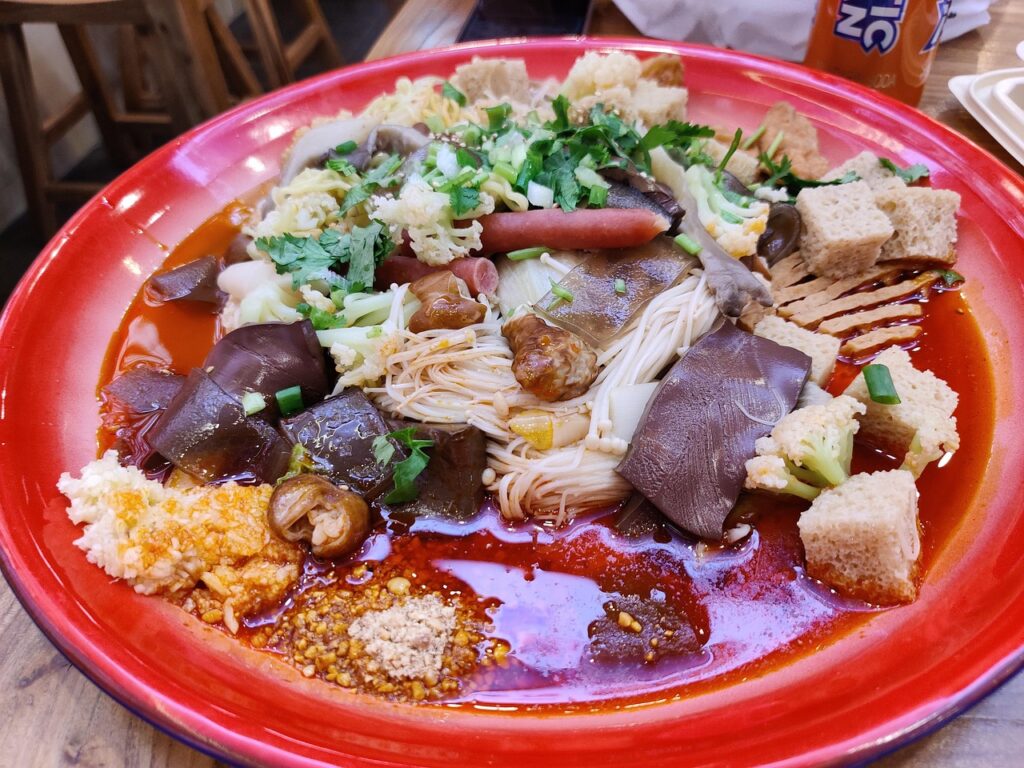
Mala Tang in Japan
Mala Tang in Japan might not be the combination you expected, but the Sichuan delicacy has become a nationwide obsession.
While the spicy, numbing hot pot has been beloved in China for years, its journey to mainstream popularity in Japan was uniquely influenced by Korean pop culture. The “Mala Tanghulu” meme, which fused the fiery hot pot with sweet Chinese fruit skewers, captured young consumers’ attention and spread rapidly across TikTok.
The true turning point came when Mala Tang was featured on the popular Japanese TV program “Matsuko no Shiranai Sekai” (“The World Matsuko Doesn’t Know”). This popularity surge created fertile ground for food businesses to capitalize on the trend, from established chains like Qibao Malatang to franchises like Yang Guo Fu Mala Tang.
The Mala Tang Cup Noodle Boom
The trend wasn’t limited to restaurants. Ishokudogen.com, a company specializing in healthy food products, released Mala Tang-flavored instant noodles that became a massive hit. Entrepreneur and influencer Ranmaru Kishitani posted on August 21 that the cup noodles were “so delicious,” praising the “richness and spiciness of the soup is unexpected from a cup noodle.” This endorsement fueled sales, proving the powerful influence of social media and influencer marketing.
Major food companies also joined in. Ajinomoto’s Mapo Tofu flavor sold over a million servings within six weeks of its August 2023 launch, becoming the top-selling new “Cook Do” product in five years. Kewpie launched “Spicy Mala Flavor” mayonnaise, while Nissin Foods released “Cup Noodle: 14 Spice Mala Tang,” integrating the flavor into familiar formats.
The Challenges
Despite rapid growth, Mala Tang businesses in Japan face operational challenges. In November 2024, a customer posted on TikTok about finding a bug at a Yang Guo Fu store, leading to trust issues. The company stated the issue stemmed from a supplier and worked to investigate.
Beyond quality control, many specialty shops struggle with customer service. Some employees aren’t fluent in Japanese, making it difficult to explain ingredients or ordering processes. Popular shops have received negative reviews citing long wait times, rude staff, inconsistent flavors, unclear pricing, and incorrect orders—significant challenges to long-term viability.
3 Lessons for Food Businesses
Friendly Customer Service
In a market valuing personalized experiences, poor communication leads to frustration. Train staff to clearly explain menu items, ordering processes, and unfamiliar ingredients like lap chiong (Chinese sausage). This builds customer confidence and ensures smooth dining experiences crucial for retention.
Ensure Consistent Quality
The viral video of a foreign object highlights how quickly reputations can be damaged on social media. Establish strict food safety standards, maintain stable supply chains, and ensure consistent taste across locations. A single negative experience can deter customers permanently.
Adapt to Local Preferences
While many Japanese consumers enjoy authentic “numbing spicy” flavors, many prefer milder versions. The success of Ajinomoto and Nissin in creating Mala-flavored products tailored to local palates demonstrates the importance of flexibility.
The Takeaway
The journey of Mala Tang in Japan—from viral sensation to food industry staple—serves as a powerful case study. While social media and influencer trends can ignite a craze, it’s commitment to quality, customer experience, and strategic adaptation that determines long-term success in competitive markets.
If you want to adapt your food to the Japanese market, we at Vintage Management are ready to help you. Contact us for a private discussion here.
Related Articles
Recent Posts
- Impact of Spain’s Pork Import Suspension and the Emerging Potential of Alternative Meat
- Case Study on Chatterbox’s Expansion to Japan: How Local Expertise Attracts Global Brands
- Singapore Employment Pass Update: COMPASS “20-Point” Universities for Overseas Professionals
- How Singapore’s Food-Stockpile Strategy Is Evolving
- Learn from Orchard Road Christmas Light-up







